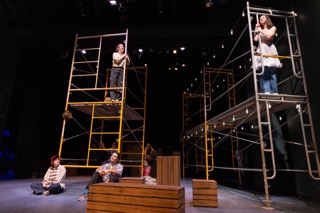
By Jack Leal
If you want to cackle it up while simultaneously spiraling into an existential crisis, “Our Town” – directed by Wind D. Woods – is the play for you. The University’s theater department premiered their rendition of the renowned play in the Norton Clapp Theatre on Oct. 27. Written in 1938 by playwright Thornton Wilder, “Our Town” takes place in a fictional rural town called Grover’s Corners between the years of 1901 and 1913. Although this play may seem like your typical warm and fuzzy Americana drama at the outset, “Our Town” covers intense existential issues concerning mortality and the realities of the human condition.
“Our Town” is a three-act play that discusses three major themes, which are all conveniently summed up by their titles: Act I: Daily Life, Act II: Love and Marriage, and Act III: Death and Eternity. The first act likes to play around, as it incorporates raw moments of human life in Grover’s Corners centered on two working-class families — the Gibbs and the Webbs — who tie the narrative together. As we learn more about Grover’s Corners, we are introduced to the town folk and get to see what they do for a living and how they interact with one another.
The second act digs a bit deeper into more significant life issues such as marriage, career paths and confronting others expectations. Here, the story focuses on two characters from the Webb and Gibbs families. George and Emily are about to confess their love to one another and get married, but the real question is: how will these events pan out? And more philosophically, how do the complexities of human beings fit into such constrictive slots that we confine ourselves in?
The themes of the third act hit on a whole other level. The audience confronts concepts like death, regret, and eternity – this is where the existential crisis starts to fester. During the third act, life is shown from different perspectives, including those of the dead. Most of this act covers how living in the moment is the only way to truly appreciate life. Ruminating what has already happened will always leave you with a “coulda-woulda-shoulda” taste in your mouth.
As far as pulling this play off successfully, the first night felt like a pilot to a sitcom. The acting was a little blocky at times, not hitting every beat perfectly. Sometimes, the cast is still figuring out how to present their characters, which can poke holes in their believability. The play’s humor tends to be very quirky, and is written to include fun, unexpected moments and awkward pauses – so it’s no surprise that some jokes fell flat with the crowd while others prevailed the first time around. But that’s the name of the game, especially on opening night: experimentation!
As most plays go, the staging is just as critical to the story as its performers are. The University’s set design was stripped to its bare essentials, with only a mound of plaster boxes and two metal-piped structures on each side of the stage. Touched on in the Director’s Notes included in the programs, this minimalist approach is intended to “get to the essence of life, the forces beyond the forms, by returning us to a nearly bare stage: ‘no curtain. No scenery.’” From the props being used to the different moments and interactions of a scene, the simplest glance can hold its weight in stars.
The show’s small prop-count helped the cast sell Grover’s Corners in an enticing and innovative manner. Because the majority of the performance was done in mime, the boxes on set were transformed into a plethora of objects, such as dining room tables, chairs and even podiums. Simplifying it further, actors who weren’t playing in certain scenes occasionally chipped in to produce sound effects in real-time. The clap of a baseball mitt would be a strip of cardboard thumped on a character’s knee or the jangling harness of an invisible horse would be two glass bottles rubbed against each other. The addition of these raw sound effects were captivating to watch and gave the show that fresh element of zhuzh.
Besides the set design and slick onstage foley work, another distinctive feature was the play’s narration. “Our Town” is the poster child for metatheatrical narratives, which was a relatively new story structure when the play was created in the 1930s. If you’ve seen a Wes Anderson film, “Our Town” doesn’t swing far from those movies’ inherent rejection of traditional storytelling techniques.
Even though meta-narratives are purposefully crafted to topple norms and traditions, the classic ‘play within a play’ has become the preferred meta-narrative archetype. Although “Our Town” technically chugs that track, the outer play, looking in, strikes a different note from other plays I’ve seen.
Minutes before the show began, the fourth wall was broken by cast members interacting with the audience. You soon realize that the characters of this play are in it for the ride as well. They know they are on a stage; they know they are performing for an audience. This explicit self-awareness of the cast is a writing choice Wilder utilized to accentuate both the simplicity and honesty of “Our Town.”
Communally watching the story unfold from the perspective of both the audience and the cast eliminates any element of illusion or deceit that a “traditional” play can potentially create. Thus, it is clear that this meta-narrative was purposefully done to exercise transparency and trust between the performers and the viewers which I found quite refreshing.
That said, “Our Town” was a fun time and Wind D. Woods and the cast should be proud of what they’ve accomplished. Although they were still figuring out a few bugs the first night round, their hard work definitely paid off and was a pleasure to watch.
